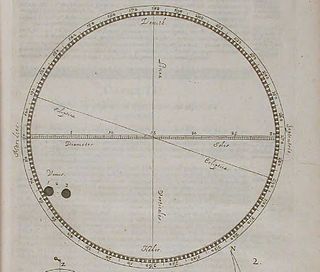Related Research Articles

Vulcan was a theorized planet that some pre-20th century astronomers thought existed in an orbit between Mercury and the Sun. Speculation about, and even purported observations of, intermercurial bodies or planets date back to the beginning of the 17th century. The case for their probable existence was bolstered by the French mathematician Urbain Le Verrier who, by 1859, had confirmed unexplained peculiarities in Mercury's orbit and predicted they had to be the result of gravitational influences of another unknown nearby planet or series of asteroids. A French amateur astronomer's report that he had observed an object passing in front of the Sun that same year led Le Verrier to announce that the long sought after planet, which he gave the name Vulcan, had been discovered at last.
The multiplication sign, also known as the times sign or the dimension sign, is the symbol ×, used in mathematics to denote the multiplication operation and its resulting product. While similar to a lowercase X, the form is properly a four-fold rotationally symmetric saltire.
The year 1874 in science and technology involved some significant events, listed below.

The year 1897 in science and technology involved some significant events, listed below.
The year 1786 in science and technology involved some significant events.
The year 1713 in science and technology involved some significant events.
The year 1630 in science and technology involved some significant events.
The year 1616 in science and technology involved some significant events.
The year 1660 in science and technology involved some significant events.
The year 1659 in science and technology involved some significant events.
The year 1622 in science and technology involved some significant events.
The year 1617 in science and technology involved some significant events.

William Oughtred, also Owtred, Uhtred, etc., was an English mathematician and Anglican clergyman. After John Napier invented logarithms and Edmund Gunter created the logarithmic scales upon which slide rules are based, Oughtred was the first to use two such scales sliding by one another to perform direct multiplication and division. He is credited with inventing the slide rule in about 1622. He also introduced the "×" symbol for multiplication and the abbreviations "sin" and "cos" for the sine and cosine functions.

The year 1639 in science and technology involved some significant events.
The year 1930 in science and technology involved some significant events, listed below.
Events from the year 1631 in England.
Algebra is the study of variables and the rules for manipulating these variables in formulas; it is a unifying thread of almost all of mathematics.
Richard Delamaine or Delamain, known as the elder, was an English mathematician, known for works on the circular slide rule and sundials.
The year 1586 in science and technology included a number of events, some of which are listed here.
William Forster was an English mathematician living in London, a pupil of the celebrated mathematician and astronomer clergyman William Oughtred (1574-1660). He is best known for his book, a translation and edition of Oughtred's treatise entitled The Circles of Proportion. Oughtred invented horizontal and circular forms of the slide rule, and Forster persuaded his master to let him translate his writings about their form and use, and to publish them. The publication resulted in a controversy, because another student of Oughtred's, Richard Delamain the elder, during the two years (1630-32) in which Forster was preparing the book, brought out two treatises on the same subject claiming the inventions as his own, and addressing himself to royal patronage. Forster's work was dedicated to that eminent intellectual, Sir Kenelm Digby (1603-1665), and the account of Oughtred's claim is found in Forster's Preface, or Letter of Dedication. Following the invention or discovery of logarithms by John Napier, in his Mirifici Logarithmorum Canonis Descriptio of 1614, the translation of that work by Edward Wright (1561-1615), and Henry Briggs's Arithmetica Logarithmica of 1624, the development of the slide rule had an important impact on the teaching of mathematics.
References
- ↑ Cajori, Florian (1919). A History of Mathematics. Macmillan. p. 157.
cajori william-oughtred multiplication.
- ↑ Pycior, Helena Mary (1997). Symbols, Impossible Numbers, and Geometric Entanglements: British Algebra through the Commentaries on Newton's Universal Arithmetick. p. 48. ISBN 0-521-48124-4.
- ↑ Hubbard, Frank (1967).